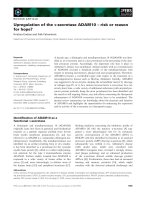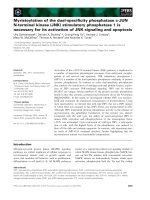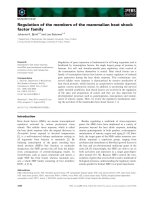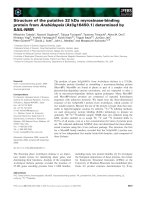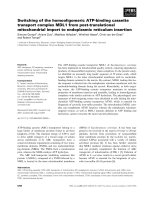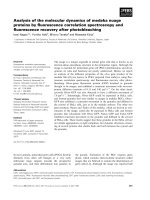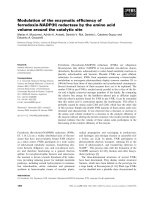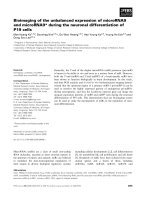Báo cáo khoa học: Pleiotropy of leptin receptor signalling is defined by distinct roles of the intracellular tyrosines docx
Bạn đang xem bản rút gọn của tài liệu. Xem và tải ngay bản đầy đủ của tài liệu tại đây (309.2 KB, 11 trang )
Pleiotropy of leptin receptor signalling is defined
by distinct roles of the intracellular tyrosines
Paul Hekerman
1
, Julia Zeidler
1
, Simone Bamberg-Lemper
1
, Holger Knobelspies
1
, Delphine Lavens
2
,
Jan Tavernier
2
, Hans-Georg Joost
3
and Walter Becker
1
1 Institute of Pharmacology and Toxicology, Medical Faculty of the Aachen University, Germany
2 The Flanders Interuniversity Institute for Biotechnology, Department of Medical Protein Research (VIB9), Ghent University, Belgium
3 German Institute of Human Nutrition (DIfE) Potsdam-Rehbru
¨
cke, Nuthetal, Germany
Leptin is an adipocyte-secreted hormone that informs
the brain about the status of the body’s energy stores.
It regulates energy homeostasis through effects on sati-
ety and energy expenditure and deficiencies of leptin or
the leptin receptor in humans or rodents result in
severe obesity, infertility, impaired growth and insulin
resistance [1]. In db ⁄ db mice that lack the signalling act-
ive, long splice variant of the leptin receptor (LEPRb),
this syndrome was largely corrected by neuron-specific
transgenic complementation of LEPRb deficiency [2],
supporting the notion that leptin acts predominantly
on central pathways. However, a number of peripheral
Keywords
leptin; leptin receptor; STAT; luciferase;
insulinoma
Correspondence
W. Becker, Institut fuer Pharmakologie und
Toxikologie, Medizinische Fakulta
¨
tder
RWTH Aachen, Wendlingweg 2, 52074
Aachen, Germany
Fax: +49 241 8082433
Tel: +49 241 8089136
E-mail:
(Received 14 July 2004, revised 9 September
2004, accepted 13 September 2004)
doi:10.1111/j.1432-1033.2004.04391.x
The leptin receptor (LEPR) is a class I cytokine receptor signalling via
both the janus kinase ⁄ signal transducer and activator of transcription
(JAK ⁄ STAT) and the MAP kinase pathways. In addition, leptin has been
shown previously to activate AMP-activated kinase (AMPK) in skeletal
muscle. To enable a detailed analysis of leptin signalling in pancreatic beta
cells, LEPR point mutants with single or combined exchanges of the three
intracellular tyrosines were expressed in HIT-T15 insulinoma cells. Western
blots with activation state-specific antibodies recognizing specific signalling
molecules revealed that the wild-type receptor activated STAT1, STAT3,
STAT5 and ERK1 ⁄ 2 but failed to alter the phosphorylation of AMPK.
Each of the three intracellular tyrosine residues in LEPR exhibited different
signalling capacities: Tyr985 was necessary and sufficient for leptin-induced
activation of ERK1 ⁄ 2; Tyr1077 induced tyrosyl phosphorylation of
STAT5; and Tyr1138 was capable of activating STAT1, STAT3 and
STAT5. Consistent results were obtained in reporter gene assays with
STAT3 or STAT5-responsive promoter constructs, respectively. Further-
more, the sequence motifs surrounding the three tyrosine residues are
conserved in LEPR from mammals, birds and in a LEPR-like cyto-
kine receptor from pufferfish. Mutational analysis of the box3 motif
around Tyr1138 identified Met1139 and Gln1141 as important deter-
minants that define specificity towards the different STAT factors. These
data indicate that all three conserved tyrosines are involved in LEPR func-
tion and define the pleiotropy of signal transduction via STAT1 ⁄ 3, STAT5
or ERK kinases. Activation and inhibition of AMPK appears to require
additional components of the signalling pathways that are not present in
beta cells.
Abbreviations
AMPK, AMP-activated kinase; ERK, extracellular signal-regulated kinase; GH, growth hormone; JAK, janus kinase; LEPR, leptin receptor;
SH2, src-homology 2; SOCS3, suppressor of cytokine signalling 3; STAT, signal transducer and activator of transcription.
FEBS Journal 272 (2005) 109–119 ª 2004 FEBS 109
actions of leptin have also been described [3]. Two
effects have been particularly well studied: the stimula-
tion of proinflammatory immune responses by direct
action on T-lymphocytes [4,5], and the inhibition of
insulin secretion from pancreatic beta cells [6–9].
As a class I cytokine receptor, LEPRb activates the
janus kinase ⁄ signal transducer and activator of tran-
scription (JAK ⁄ STAT) signalling pathway [10,11]. Lig-
and binding to LEPRb results in the activation of
JAK2 by transphosphorylation and subsequent phos-
phorylation of tyrosine residues in the cytoplasmic part
of LEPRb [10,12,13]. These phosphorylated tyrosines
provide docking sites for signalling proteins with src-
homology 2 (SH2) domains. A short splicing variant
of the leptin receptor (LEPRa) is abundantly expressed
in most tissues but lacks tyrosine residues and appears
to be signalling-inactive [14]. Murine LEPRb contains
three intracellular tyrosine residues that are conserved
in mammals and birds [15,16]. Tyr1138 is located in a
canonical box3 motif (Tyr-x-x-Gln) and recruits the
transcription factor STAT3, which is subsequently
phosphorylated by JAK2, dimerizes and translocates
to the nucleus. Here it binds to the promoter regions
of target genes. Leptin-induced phosphorylation and
nuclear translocation of STAT3 has been demonstra-
ted in vivo in the hypothalamus [17,18], in isolated
T-lymphocytes [19] and in insulin secreting cells
[20,21]. Mice with a targeted mutation of Tyr1138
(lepr
S1138
) are hyperphagic and obese, underscoring the
essential role of STAT3 in energy homeostasis [22].
However, whereas db⁄ db mice are infertile, short and
diabetic, lepr
S1138
mice are fertile, longer and appear to
be less hyperglycemic. This result clearly indicates that
STAT3-independent pathways play an important role
in LEPRb signalling. Of the two other intracellular
tyrosine residues in LEPRb, Tyr985 can recruit either
the tyrosine phosphatase SHP-2 or suppressor of cyto-
kine signalling 3 (SOCS3) [15,23–26]. Binding of
SOCS3 to Tyr-985 attenuates leptin signalling by inhi-
bition of the receptor-associated JAK kinase [25]. In
contrast, recruitment of SHP-2 does not alter JAK2
activity but results in GRB2 binding to SHP-2 and
activation of the RAS ⁄ RAF ⁄ ERK pathway [26,27]. In
contrast to Tyr985 and Tyr1138, the role of Tyr1077
in leptin signalling is not yet clear.
More recently, it has been shown that AMP-depend-
ent protein kinase (AMPK) appears to be a down-
stream mediator of leptin signalling. Leptin directly
stimulates phosphorylation and activation of the a2
catalytic subunit of AMPK in muscle [28]. In contrast,
leptin suppresses a2 AMPK activity in secondary
hypothalamic neurons indirectly via activation of
agouti-related protein (AGRP) neurons [29].
The aim of this study was to analyse the contribu-
tion of the intracellular tyrosine residues to LEPRb-
mediated effects on STAT factors, MAP kinase and
AMPK. These data show that LEPRb is capable of
activating a broader range of STAT factors than other
cytokines such as interleukin-6 (IL-6) and growth hor-
mone (GH). Analysis of point mutants revealed that
each of the individual tyrosine residues in the intracel-
lular part of LEPRb exhibits a different signalling
capacity. In particular, our data identify Tyr1077 as a
docking site for STAT5.
Results
Leptin receptor signal transduction in HIT-T15
and RINm5F insulinoma cells
We used HIT-T15 insulinoma cells as a model system
to characterize leptin receptor signalling in pancreatic
beta cells. The cells were stimulated either with leptin,
IL-6 or GH to compare the activation of downstream
signalling pathways by the different cytokines.
Although HIT-T15 cells have previously been reported
to be leptin responsive [30,31] we observed no leptin-
induced phosphorylation of STAT1, STAT3, STAT5
or ERK1 ⁄ ERK2 in untransfected cells (Fig. 1A). IL-6
and GH elicited the expected responses, i.e. tyrosine
phosphorylation of STAT3 and STAT5, respectively.
In HIT-T15 cells transfected with cDNA of LEPRb,
phosphorylation of STAT1, STAT3, STAT5 and the
ERK kinases was induced by leptin. The weak
response of STAT5 to leptin compared to that elicited
by GH can be partially explained by the rather ineffec-
tive transfection of the HIT-T15 cells (estimated at
10–20% of transfected cells). Cells expressing the short
splice variant of the leptin receptor (LEPRa) showed
no detectable response to leptin.
We used rat RINm5F cells as a second insulinoma
cell line to confirm these results. Contrary to published
data [20], treatment of nontransfected cells with leptin
failed to elicit a detectable reponse to leptin (data not
shown). Therefore, we constructed a retroviral vector
in which the MuMLV long-terminal repeat controlled
the expression of murine LEPRb. Infection of RINm5F
cells with the recombinant retrovirus generated poly-
clonal pools of cells stably expressing LEPRb. In these
cells (Fig. 1B), leptin and IL-6 stimulated tyrosine
phosphorylation of STAT3 to a similar degree, but lep-
tin again induced activation of a broader spectrum of
STAT factors (STAT1, STAT3, STAT5, STAT6).
Leptin has recently been reported to activate AMPK
in muscle cells, thereby stimulating expression
of enzymes involved in fatty acid oxidation [28].
Pleiotropic leptin receptor signalling P. Hekerman et al.
110 FEBS Journal 272 (2005) 109–119 ª 2004 FEBS
Previously, leptin has also been shown to prevent lipo-
toxicity in pancreatic islets by upregulating expression
of fatty acid oxidation-related enzymes (carnitine
palmitoyl transferase, acyl CoA oxidase) [32,33].
Therefore, we analysed the effect of leptin on AMPK
in the insulinoma cell lines. As shown in Fig. 1C, lep-
tin treatment failed to alter the activating phosphoryla-
tion of AMPK in HIT-T15 cells or in RINm5F cells.
As a positive control, AMPK phosphorylation was
readily stimulated in glucose-depleted cells, indicating
that essential components of the AMPK pathway were
present in these cell lines.
Role of the intracellular tyrosine residues
in LEPRb
To determine the role of the three intracellular tyrosine
residues (Tyr985, Tyr1077, Tyr1138) in LEPR-medi-
ated activation of downstream signalling events, con-
structs in which phenylalanine(s) replaced either one of
the three tyrosines or combinations of them were
expressed in HIT-T15 cells. The specific signalling
capacities of each tyrosine residue in the intracellular
domain of LEPRb can be deduced from the results
presented in Fig. 2. Tyr985 is necessary and sufficient
A
C
B
Fig. 1. Leptin signalling in insulinoma cell lines. (A) HIT-T15 cells were transfected with expression plasmid encoding either the short
(LEPRa) or the long splicing variant (LEPRb) of the leptin receptor or were not transfected. Cells were serum-starved for 22 h and stimulated
with the indicated cytokine (Lep, leptin; sIL-6R, soluble IL-6 receptor; GH, growth hormone) for 15 min. Total cellular lysates were used for
Western blot analysis with phospho-specific antibodies against STAT1, STAT3, STAT5A ⁄ B, and ERK1 ⁄ 2. The STAT5 antibody does not dis-
criminate between STAT5A and STAT5B. (B) RINm5F cells stably expressing LEPRb were stimulated with cytokines for 15 min. Nuclear
extracts (left panels) or total cellular lysates (right panels) were subjected to Western blot analysis with the indicated phospho-specific anti-
bodies. The phospho-STAT6 antibody crossreacted with phospho-STAT5 (indicated by asterisks). (C) HIT-T15 cells (left panels) or RINm5F
cells (right panels) ectopically expressing LEPRb were treated with leptin (Lep) or with vehicle alone (Ø). The activating phosphorylation of
AMPK was detected by immunoblotting with a phosphospecific antibody. As positive controls for AMPK activation, HIT-T15 cells were glu-
cose deprived for 15 min in phosphate buffered saline, and RINm5F cells were starved by overnight-incubation without change of the med-
ium. Tyrosyl phosphorylation of STAT3 is shown as a positive control for the leptin effect (lower panel).
P. Hekerman et al. Pleiotropic leptin receptor signalling
FEBS Journal 272 (2005) 109–119 ª 2004 FEBS 111
for activation of ERK1 ⁄ ERK2, either Tyr1077 or
Tyr1138 is required for leptin-induced tyrosyl phos-
phorylation of STAT5, and Tyr1138 is essential for
activation of STAT1 and STAT3. Note that leptin-
induced STAT5 phosphorylation was weakly detect-
able in cells transfected with the triple mutant of
LEPRb (FFF); this effect was variable in its magnitude
and may be due the overexpression of STAT5B in this
experiment.
We next studied the capacity of the LEPRb point
mutants to induce reporter gene activity driven by
STAT response elements. Two different reporter con-
structs were used. In the first one (a
2
M), luciferase
expression is driven by the IL-6 responsive element of
the a
2
-macroglobulin promoter, which is controlled
by STAT3 [34]. The second reporter plasmid (spi2.1)
contains the GH-responsive element of the rat serine
protease inhibitor 2.1 (spi2.1) gene, whose expression
is controlled by STAT5 [35]. Assays with the different
promoter constructs were performed under identical
conditions to analyse the ability of the LEPR point
mutants to specifically activate STAT3- and STAT5-
driven promoter activity (Fig. 3). Consistent with the
detection of tyrosine phosphorylated STAT factors by
Western blot analysis, all LEPRb constructs contain-
ing the Tyr1138fiPhe mutation (YYF, FYF, YFF,
FFF) were severely reduced in their capacity to sti-
mulate a
2
M reporter gene activity. It is likely that
the residual activation by the mutants retaining
Tyr1077 (YYF, FYF) can be explained by the action
of STAT5. Spi2.1 promoter activity was stimulated
by all constructs containing either Tyr1077 or
Tyr1138, in full agreement with the presumed control
by STAT5. As expected, Tyr985 was not able to
induce reporter gene activity driven by STAT-depend-
ent promoters. Interestingly, the data point to an
inhibitory function of Tyr1138 in these assays, as the
mutation of Tyr1138 enhanced luciferase activity
(YYF vs. WT, P < 0.001, double-sided t-test). This
result is consistent with the known requirement of
Tyr1138 for induction of the feedback-inhibitor pro-
tein SOCS3 [27].
Fig. 2. Signalling by leptin receptor mutants in HIT-T15 cells. HIT-T15 cells were transfected with expression plasmids for the indicated
LEPRb point mutants (left panels, single point mutants; right panels, double mutants) and for STAT5B. Cells were treated with 100 ngÆmL
)1
leptin or vehicle for 15 min before nuclear extracts were prepared. Leptin-induced phosphorylation of downstream signalling molecules was
assayed by Western blotting and immunodetection with phospho-specific antibodies. Postnuclear supernatants were probed with a LEPR-
specific antibody to verify comparable expression of the LEPRb mutants. One representative experiment out of three is shown.
Pleiotropic leptin receptor signalling P. Hekerman et al.
112 FEBS Journal 272 (2005) 109–119 ª 2004 FEBS
Structural basis for the recruitment of different
STAT factors by Tyr1138
The unusual capacity of the box3 motif in LEPRb to
mediate activation of STAT1, STAT3 and STAT5
stimulated us to characterize the structural determi-
nants required for binding of each of these proteins.
Four point mutations targeting the residues C-terminal
of Tyr1138 were generated to test their potential role
in binding of the different STAT factors (Fig. 4). A
glutamine found three amino acids after the phosphor-
ylated tyrosine (position P+3, where P is the phos-
phorylation site), fitting the consensus STAT3-binding
motif (YXXQ) [36], was exchanged for valine, which is
found in this position in the Tyr1077 motif. A proline
residue at P+2 has been proposed to be important for
binding of STAT1 by the IL-6 receptor gp130 [37] and
was exchanged for glycine. A consensus sequence for
binding of STAT5 has not yet been explicitly defined
but in most cases the phosphorylated tyrosine is fol-
lowed by an aliphatic hydrophobic residue such as leu-
cine, isoleucine, valine or methionine [38–41]. The
constructs were transiently expressed in HIT-T15 cells,
and leptin-induced activation of STAT factors was
monitored by Western blot analysis with phospho-spe-
cific antibodies and by reporter gene assays (Fig. 4).
Consistent with the established consensus sequence for
binding of STAT3, mutation of Gln1141 abolished lep-
tin-induced phosphorylation of STAT3 and decreased
the activation of the a
2
M-derived promoter but did
not affect STAT5 phosphorylation or induction of the
spi2.1 promoter. In contrast, exchange of Met1139 for
alanine or arginine eliminated phosphorylation of
STAT5 and reduced induction of the spi2.1 promoter
construct. This promoter is probably also responsive
to STAT1 and ⁄ or STAT3. Mutation of Pro1140
strongly reduced activation of all three STAT proteins.
Taken together, these results indicate that the combi-
nation of a hydrophobic residue in the P+1 position
and the glutamine in P+3 allows the binding of either
STAT1, STAT3 or STAT5 to pTyr-1138 in LEPRb.
Discussion
Class I cytokine receptors such as LEPRb transmit
extracellular signals by recruiting SH2 domain-contain-
ing proteins to phosphorylated tyrosine residues. Until
now, only two of the three conserved tyrosines in
LEPRb (Tyr985 and Tyr1138) have been demonstrated
to play a role in leptin signalling [22–27]. Our analysis
of LEPRb point mutants in insulinoma cell lines indi-
cates that the presence of Tyr1077 as the only intracel-
lular tyrosine residue was sufficient to induce tyrosine
phosphorylation of STAT5 (in HIT-T15 and RINm5F
cells), and to stimulate STAT5-driven reporter gene
activity (in HIT-T15 cells). These results establish that
all of the three intracellular tyrosines in murine LEP-
Rb participate in leptin signal transduction and have
different capacities to activate downstream signalling
pathways. Tyr985 is required for the activation of the
RAS ⁄ RAF ⁄ ERK pathway, Tyr1077 mediates the acti-
vation of STAT5, and Tyr1138 can stimulate tyrosine
phosphorylation of STAT1, STAT3 or STAT5.
Leptin has previously been reported to stimulate
AMPK in muscle and, more recently, to inhibit the
kinase in hypothalamic nuclei [28,29]. We therefore
Fig. 3. Effects of leptin receptor mutants on STAT-responsive pro-
moter elements. HIT-T15 cells on six-well plates were transfected
with luciferase reporter constructs driven by the IL-6-response ele-
ment of the a
2
macroglobulin promoter (a2M) or by the GH-
response element of serine protease inhibitor 2.1 promoter (spi2.1),
b-galactosidase reporter control plasmid, and the indicated LEPRb
expression plasmids. Twenty-four hours after transfection, cells
were treated or untreated with leptin (100 ngÆmL
)1
) for 18 h. The
luciferase activity was determined and normalized to coexpressed
b-galactosidase activity. Data are expressed as fold stimulation rel-
ative to unstimulated cells. Bars reflect means ± SEM of three
(a2M) or four to five independent experiments (spi2.1). The bottom
panel of Fig. 2 provides an expression control for the different
LEPR mutants as aliquots of the same DNA samples were trans-
fected in this experiment.
P. Hekerman et al. Pleiotropic leptin receptor signalling
FEBS Journal 272 (2005) 109–119 ª 2004 FEBS 113
expected to observe a reduced or increased phosphory-
lation of AMPK in response to leptin in the pancreatic
beta cell lines. However, concentrations of leptin that
maximally activated STAT3 failed to alter AMPK phos-
phorylation (Fig. 1C). Glucose deprivation induced the
anticipated activation of AMPK, indicating that the
upstream kinase is present in the cells. Consistent with
our results, Leclerc et al. [42] recently reported that
leptin did not change AMPK activity in murine MIN6
insulinoma cells and in isolated rat islets. Thus, we
conclude that pancreatic beta cells lack a component
required for leptin-induced activation of AMPK, pos-
sibly the c3 subunit of AMPK which appears to speci-
fically expressed in skeletal muscle [42].
Our conclusion that Tyr1077 in murine LEPRb
plays an important role in leptin signalling is
supported by the fact that the surrounding sequence is
strikingly conserved in mammals and birds [15],
although the intracellular domains of murine and
chicken LEPRb show little overall sequence similarity
(25% of identical amino acids distal of the JAK kinase
binding motif). Moreover, our database searches for
A
B
Fig. 4. Mutational analysis of the box3 motif and sequence conservation of the intracellular tyrosine motifs in LEPRb. (A) Mutations of the
amino acids following Tyr1138 were introduced into LEPRb-FFY. HIT-T15 cells were transfected with the LEPRb constructs indicated by the
sequence of the wild type (YMPQ, identical with FFY in Figs 2 and 3) or mutated box3 motif (YRPQ, YAPQ, YMGQ, YMPV, and FMPQ,
which is identical with FFF). Western blot analysis of STAT phosphorylation in nuclear extracts (left panels) and reporter gene assays (right
diagrams) were performed as described in the legends to Figs 2 and 3. Expression levels of the overexpressed proteins were assessed by
Western blot analysis of postnuclear supernatants (STAT5, LEPR). Luciferase activities are represented as percent of the YMPQ construct.
Bars (open bars, no leptin; filled bars, 100 ngÆmL
)1
leptin) reflect means ± SD of three to five independent experiments (except n ¼ 2 for
YAPQ). (B) Sequences from murine, human, chicken and pufferfish (Tetraodon nigroviridans) LEPR are shown as representatives for mam-
mals, birds and fish. Consensus sequences are given in the bottom line (/, hydrophic residue). The localization of the tyrosines in murine
LEPRb is illustrated (985, 1077, 1138). Proteins recruited to the phosphotyrosine motifs are indicated below the alignments. NCBI protein
database accession numbers for the LEPR sequences are P48356 (mouse); NP_002294 (human), AAF31355 (chicken) and AAR25693
(Tetraodon).
Pleiotropic leptin receptor signalling P. Hekerman et al.
114 FEBS Journal 272 (2005) 109–119 ª 2004 FEBS
LEPR homologues in more distantly related verte-
brates identified LEPR-related sequences from green
pufferfish (Tetraodon nigroviridans; NCBI protein
accession AAR25693) and zebrafish (Danio rerio;
ENSEMBL predicted protein ENSDARP00000011908)
containing the three tyrosine phosphorylation motifs
(Fig. 4B). Sequence comparisons indicated that these
proteins are more closely related with LEPR than with
any other mammalian cytokine receptor: the sequence
from pufferfish contains 30% of identical amino acids
with murine LEPRb and 27% with murine gp130, the
signal transducing subunit of the IL-6 receptor (gaps
> 50 amino acids were not penalized). The intracellu-
lar domain shows no significant similarity with any
known mammalian protein except for LEPRb.
Tyr-1077 has previously been shown to play a role
in down-regulation of LEPRb signalling, presumably
by serving as a docking site for SOCS3 [15]. The con-
servation of the aliphatic hydrophobic residue in the
P+1 position after Tyr-1077 is also compatible with
the known requirements of STAT5-binding as deter-
mined in different receptors [38,40,41]. Leptin-induced
activation of STAT5 has already been described in the
first papers reporting STAT signalling by the LEPRb
[10,43]. Later, in vivo studies suggested that only
STAT3 is activated upon leptin administration in the
hypothalamus of mice and rats [17,44]. However,
leptin-induced tyrosine phosphorylation has been
observed in various cell types, e.g. hypothalamic GT1-
7 cells [45], intestinal L-cells [46], enterocyte-like
CaCo-2 cell line [47], and H-35 hepatoma cells [48].
Our results are also consistent with earlier reports that
mutant constructs of the human LEPRb either with a
substitution of Tyr1141 for phenylalanine or with a
deletion of the C-terminus including Tyr1141 were still
able to induce DNA binding of overexpressed
STAT5B in electrophoretic mobility shift assays
[10,49]. It should be noted that leptin-induced activa-
tion of STAT5 in the insulinoma cell lines was detect-
able with endogenous levels of STAT factors (Figs 1, 3
and 4). Changing the ratio of STAT factors in a cell
can strikingly alter the downstream effects of a recep-
tor, particularly when different STATs compete for
binding to the same tyrosine residue [50].
In pancreatic b-cells, prolactin and growth hormone
are physiological inducers of STAT5 [51]. Both hor-
mones stimulate insulin production and b-cell prolifer-
ation via STAT5-dependent pathways [52] and may
contribute to islet hyperplasia in pregnancy [51]. Inter-
estingly, leptin has also been reported to stimulate pro-
liferation and suppress apoptosis of islet cells [53–55].
It is conceivable that this effect of leptin is mediated
by activation of STAT5.
An unexpected finding was the capability of Tyr1138,
which is located within a canonical box3 consensus
motif, to mediate activation of STAT5. The results of
our mutational analysis are consistent with findings
obtained with other cytokine receptors: the position
after the phosphotyrosine (P +1) is critical for binding
of STAT5 but not of STAT1 or STAT3, whereas the
glutamine in position P +3 is required for binding of
STAT1 and STAT3, but is not relevant for STAT5. This
result is consistent with the fact that residues C-terminal
of the phosphotyrosine are important for binding of
SH2 domains [55a]. Equivalent results have been
obtained by mutational analysis of the STAT binding
motif of the IL-9 receptor TyrLeuProGln(367–370),
which is also capable to activate STAT1, STAT3, and
STAT5 [39,56]. It should be noted, however, that the
same sequence motifs in gp130 [TyrLeuProGln(905–
908)] and [TyrMetProGln(915–918)] do not activate
STAT5, indicating that the hydrophobic residue in
P +1 is not the only residue required for binding of
STAT5.
Experimental procedures
Reagents
Recombinant murine leptin was obtained from PeproTec
(London, UK) and GH from Bachem (Bubendorf, Switzer-
land). Recombinant human IL-6 and soluble IL-6 receptor
were kindly provided by Gerhard Mu
¨
ller-Newen (Depart-
ment of Biochemistry, Aachen University). The following
primary antibodies were used: polyclonal rabbit antibodies
against p(Y701)-STAT1, p(Y705)-STAT3, p(Y694)-STAT5,
p(Y641)-STAT6, STAT1, STAT3, p(T172)-AMPK, anti-
AMPK, anti-pTyr Ig PY100, and phospho p42 ⁄ 44 MAP
kinase from Cell Signalling Technology (Beverly, MA),
anti-STAT5A ⁄ B from Upstate (Charlottesville, VA, USA),
goat anti-(mouse LEPR) Ig from R&D Systems (Wiesba-
den, Germany), antibody against phosphorylated JAK2
(pYpY1007 ⁄ 1008) from BioSource Technologies (Cama-
rillo, CA) and anti-pTyr Igs PY20 from Transduction
Laboratories, Inc. (San Diego, CA). Horseradish peroxi-
dase-labeled anti-(rabbit IgG) (IgG-POD) was obtained
from Pierce Chemical Co. (Rockford, IL), anti-(mouse
IgG-POD) from Amersham (Buckinghamshire, UK), and
anti-(goat IgG-POD) from Dianova (Hamburg, Germany).
Cell culture, transient transfection, and retroviral
infection
HIT-T15 hamster insulinoma cells (gift of A. Schu
¨
rmann,
Potsdam) and RINm5F rat insulinoma cells (gift of D. Meyer
zu Heringdorf, Essen) were cultivated in RPMI 1640
P. Hekerman et al. Pleiotropic leptin receptor signalling
FEBS Journal 272 (2005) 109–119 ª 2004 FEBS 115
medium with l-glutamine, 10% (v ⁄ v) fetal bovine serum,
100 unitsÆmL
)1
penicillin, and 100 mgÆmL
)1
streptomycin.
The medium was further supplemented with 5% (v ⁄ v) horse
serum for culture of HIT-T15 cells. For analysis of total
cell lysates (Fig. 1), 4 · 10
5
HIT-T15 cells on six-well plates
plates were transfected with 1.0 lg of pSVL-LEPR plas-
mids [14]. For preparation of nuclear extracts (Fig. 2),
1 · 10
6
cells on 6-cm plates were transfected with 1.5 lgof
pMET7-mLRlo constructs [57] using the JET-PEI transfec-
tion reagent (Polyplus-transfection, Illkirch, France). If
indicated (Fig. 2), 1.0 lg of pECE-STAT5B expression
plasmid was cotransfected. Point mutants targeting the resi-
dues C-terminal of Tyr1138 in LEPRb were generated with
the help of the QuikChange
TM
Site-Directed Mutagenesis
Kit (Stratagene).
For stable expression in RINm5F cells, LEPRb was sub-
cloned from pSVL-LEPRb into the retroviral vector
pWZL-Neo. Viruses were produced in 293T cells, and con-
fluent RINm5F cells were infected with pWZL-neo-LEPR
viruses [58]. Selection was performed for 14 days in
1mgÆmL
)1
of G418.
Western blot analysis and EMSA
Cells were incubated in serum-free medium for 18–22 h
before leptin (100 ngÆmL
)1
), IL-6 (200 U mL
)1
), or GH
(500 ngÆmL
)1
) was added for 15 min. All assays of transi-
ently transfected HIT-T15 cells were performed 48 h after
transfection. Nuclear extracts were prepared by hypotonic
lysis [34]. To prepare total cellular lysates, cells were
washed with phosphate buffered saline and lysed in 1%
(w ⁄ v) SDS, 20 mm Tris ⁄ HCl pH 7.4 in a boiling water bath
for 5 min. For Western blot analysis, protein samples were
separated by SDS ⁄ PAGE (8% gels), blotted on to nitrocel-
lulose, and specific proteins were detected by chemilumines-
cence using the primary antibodies mentioned above and
horseradish peroxidase-labeled secondary antibody. Blots
were re-used after stripping the primary antibody by incu-
bation in 2% (w ⁄ v) SDS, 50 mm Tris ⁄ HCl, 150 mm NaCl,
pH 7.4 in the presence of 100 m m 2-mercaptoethanol.
Reporter gene assays
Luciferase reporter constructs contained the promoter
region )215 to +8 of the rat a
2
-macroglobulin gene
(pGL3a2 m-215Luc; kindly provided by P. C. Heinrich,
Department of Biochemistry, Aachen, Germany) for assays
of STAT3-driven promoter activity [59] or six copies of
the GH-responsive GAS-like element (GLE) from the
rat spi2.1 gene (pSpi-GLE-Luc, gift of L A. Haldosen,
Karolinska Institutet, Huddinge, Sweden) for assays of
STAT5-dependent promoter activity [35]. HIT-T15 cells on
six-well plates (3.5 · 10
5
cells per well) were transfected
with 0.3 lg of pMET7-LEPRb expression plasmids along
with 0.75 lg each of the luciferase reporter construct and
the b-galactosidase reporter control plasmid pSVb-gal
(Promega). Transcription of the lacZ gene in this control
vector is driven by the SV40 early promoter and enhancer.
Twenty-four hours after transfection, the cells were stimu-
lated with 100 ngÆmL
)1
leptin for 22 h in serum-free med-
ium. Luciferase activities were determined from duplicate
wells with the help of a commercial kit (Promega), and
data were normalized to b-galactosidase activities.
Acknowledgements
We thank Drs Lars-Arne Haldosen, Gerhard Mu
¨
ller-
Newen, Peter C. Heinrich, Annette Schu
¨
rmann, Dag-
mar Meyer zu Heringdorf for generous donations of
reagents and cell lines. This work was supported by
the Deutsche Forschungsgemeinschaft (SFB 542).
References
1 Friedman JM & Halaas JL (1998) Leptin and the regula-
tion of body weight in mammals. Nature 395, 763–770.
2 Kowalski TJ, Liu SM, Leibel RL & Chua SC Jr (2001)
Transgenic complementation of leptin-receptor
deficiency. I. Rescue of the obesity ⁄ diabetes phenotype
of LEPR-null mice expressing a LEPR-B transgene.
Diabetes 50, 425–435.
3 Margetic S, Gazzola C, Pegg GG & Hill RA (2002)
Leptin: a review of its peripheral actions and interac-
tions. Int J Obes Relat Metab Disord 26, 1407–1433.
4 Lord GM, Matarese G, Howard JK, Baker RJ, Bloom
SR & Lechler RI (1998) Leptin modulates the T-cell
immune response and reverses starvation-induced
immunosuppression. Nature 394, 897–901.
5 Lord GM, Matarese G, Howard JK, Bloom SR &
Lechler RI (2002) Leptin inhibits the anti-CD3-driven
proliferation of peripheral blood T cells but enhances
the production of proinflammatory cytokines. J Leukoc
Biol 72, 330–338.
6 Kulkarni RN, Wang ZL, Wang RM, Hurley JD,
Smith DM, Ghatei MA, Withers DJ, Gardiner JV,
Bailey CJ & Bloom SR (1997) Leptin rapidly sup-
presses insulin release from insulinoma cells, rat and
human islets and, in vivo, in mice. J Clin Invest 100,
2729–2736.
7 Ookuma M, Ookuma K & York DA (1998) Effects of
leptin on insulin secretion from isolated rat pancreatic
islets. Diabetes 47, 219–223.
8 Kieffer TJ & Habener JF (2000) The adipoinsular axis:
effects of leptin on pancreatic beta-cells. Am J Physiol
Endocrinol Metab 278, E1–E14.
9 Seufert J, Kieffer TJ & Habener JF (1999) Leptin inhi-
bits insulin gene transcription and reverses hyperinsuli-
nemia in leptin-deficient ob ⁄ ob mice. Proc Natl Acad
Sci USA 96, 674–679.
Pleiotropic leptin receptor signalling P. Hekerman et al.
116 FEBS Journal 272 (2005) 109–119 ª 2004 FEBS
10 Baumann H, Morella KK, White DW, Dembski M,
Bailon PS, Kim H, Lai CF & Tartaglia LA (1996) The
full-length leptin receptor has signalling capabilities of
interleukin 6-type cytokine receptors. Proc Natl Acad
Sci USA 93, 8374–8378.
11 Tartaglia LA (1997) The leptin receptor. J Biol Chem
272, 6093–6096.
12 Bjørbaek C, Uotani S, da Silva B & Flier JS (1997)
Divergent signaling capacities of the long and short
isoforms of the leptin receptor. J Biol Chem 272,
32686–32695.
13 Ghilardi N & Skoda RC (1997) The leptin receptor acti-
vates janus kinase 2 and signals for proliferation in a
factor-dependent cell line. Mol Endocrinol 11, 393–369.
14 Bahrenberg G, Behrmann I, Barthel A, Hekerman P,
Heinrich PC, Joost HG & Becker W (2002) Identifica-
tion of the critical sequence elements in the cytoplasmic
domain of leptin receptor isoforms required for Janus
kinase ⁄ signal transducer and activator of transcription
activation by receptor heterodimers. Mol Endocrinol
16, 859–872.
15 Eyckerman S, Broekaert D, Verhee A, Vandekerck-
hove J & Tavernier J (2000) Identification of the Y985
and Y1077 motifs as SOCS3 recruitment sites in the
murine leptin receptor. FEBS Lett 486, 33–37.
16 Horev G, Einat P, Aharoni T, Eshdat Y & Friedman-
Einat M (2000) Molecular cloning and properties of
the chicken leptin-receptor (CLEPR) gene. Mol Cell
Endocrinol 162, 95–106.
17 Vaisse C, Halaas JL, Horvath CM, Darnell JE Jr,
Stoffel M & Friedman JM (1996) Leptin activation of
Stat3 in the hypothalamus of wild-type and ob ⁄ ob
mice but not db ⁄ db mice. Nat Genet 14, 95–97.
18 Hu
¨
bschle T, Thom E, Watson A, Roth J, Klaus S &
Meyerhof W (2001) Leptin-induced nuclear transloca-
tion of STAT3 immunoreactivity in hypothalamic
nuclei involved in body weight regulation. J Neurosci
21, 2413–2424.
19 Maccarrone M, Di Rienzo M, Finazzi-Agro A & Rossi
A (2003) Leptin activates the anandamide hydrolase
promoter in human T lymphocytes through STAT3.
J Biol Chem 278, 13318–13324.
20 Morton NM, Emilsson V, de Groot P, Pallett AL &
Cawthorne MA (1999) Leptin signalling in pancreatic
islets and clonal insulin-secreting cells. J Mol Endocri-
nol 22, 173–184.
21 Briscoe CP, Hanif S, Arch. JR & Tadayyon M (2001)
Fatty acids inhibit leptin signalling in BRIN-BD11
insulinoma cells. J Mol Endocrinol 26, 145–154.
22 Bates SH, Stearns WH, Dundon TA, Schubert M, Tso
AW, Wang Y, Banks AS, Lavery HJ, Haq AK, Mara-
tos-Flier E, Neel BG, Schwartz MW & Myers MG Jr
(2003) STAT3 signalling is required for leptin regula-
tion of energy balance but not reproduction. Nature
421, 856–859.
23 Carpenter LR, Farruggella TJ, Symes A, Karow ML,
Yancopoulos GD & Stahl N (1998) Enhancing leptin
response by preventing SH2–containing phosphatase 2
interaction with Ob receptor. Proc. Natl. Acad. Sci.
USA 95, 6061–6066.
24 Li C & Friedman JM (1999) Leptin receptor activation
of SH2 domain containing protein tyrosine phospha-
tase 2 modulates Ob receptor signal transduction. Proc
Natl Acad Sci USA 96, 9677–9682.
25 Bjørbaek C, Lavery HJ, Bates SH, Olson RK, Davis
SM, Flier JS & Myers MG Jr (2000) SOCS3 mediates
feedback inhibition of the leptin receptor via Tyr985.
J Biol Chem 275, 40649–40657.
26 Bjørbaek C, Buchholz RM, Davis SM, Bates SH,
Pierroz DD, Gu H, Neel BG, Myers MG Jr & Flier JS
(2001) Divergent roles of SHP-2 in ERK activation by
leptin receptors. J Biol Chem 276, 4747–4755.
27 Banks AS, Davis SM, Bates SH & Myers MG Jr
(2000) Activation of downstream signals by the long
form of the leptin receptor. J Biol Chem 275, 14563–
14572.
28 Minokoshi Y, Kim YB, Peroni OD, Fryer LG, Muller
C, Carling D & Kahn BB (2002) Leptin stimulates
fatty-acid oxidation by activating AMP-activated pro-
tein kinase. Nature 415, 339–343.
29 Minokoshi Y, Alquier T, Furukawa N, Kim YB,
Lee A, Xue B, Mu J, Foufelle F, Ferre P, Birnbaum
MJ, Stuck BJ & Kahn BB (2004) AMP-kinase regu-
lates food intake by responding to hormonal and
nutrient signals in the hypothalamus. Nature 428,
569–574.
30 Shimizu H, Ohtani K, Tsuchiya T, Takahashi H,
Uehara Y, Sato N & Mori M (1997) Leptin stimulates
insulin secretion and synthesis in HIT-T 15 cells. Pep-
tides 18, 1263–1266.
31 Tsiotra PC, Tsigos C & Raptis SA (2001) TNFalpha
and leptin inhibit basal and glucose-stimulated insulin
secretion and gene transcription in the HIT-T15 pan-
creatic cells. Int J Obes Relat Metab Disord 25, 1018–
1026.
32 Zhou YT, Shimabukuro M, Koyama K, Lee Y, Wang
MY, Trieu F, Newgard CB & Unger RH (1997) Induc-
tion by leptin of uncoupling protein-2 and enzymes of
fatty acid oxidation. Proc Natl Acad Sci USA 94,
6386–6390.
33 Zhou YT, Shimabukuro M, Wang MY, Lee Y, Higa
M, Milburn JL, Newgard CB & Unger RH (1998)
Role of peroxisome proliferator-activated receptor
alpha in disease of pancreatic beta cells. Proc Natl
Acad Sci USA 95, 8898–8903.
34 Wegenka UM, Buschmann J, Lu
¨
tticken C, Heinrich
PC & Horn F (1993) Acute-phase response factor, a
nuclear factor binding to acute-phase response ele-
ments, is rapidly activated by interleukin-6 at the post-
translational level. Mol Cell Biol 13, 276–288.
P. Hekerman et al. Pleiotropic leptin receptor signalling
FEBS Journal 272 (2005) 109–119 ª 2004 FEBS 117
35 Wood TJ, Sliva D, Lobie PE, Goullieux F, Mui AL,
Groner B, Norstedt G & Haldosen LA (1997)
Specificity of transcription enhancement via the STAT
responsive element in the serine protease inhibitor 2.1
promoter. Mol Cell Endocrinol 130, 69–81.
36 Stahl N, Farruggella TJ, Boulton TG, Zhong Z,
Darnell JE Jr & Yancopoulos GD (1995) Choice of
STATs and other substrates specified by modular tyr-
osine-based motifs in cytokine receptors. Science 267,
1349–1353.
37 Gerhartz C, Heesel B, Sasse J, Hemmann U, Landgraf
C, Schneider-Mergener J, Horn F, Heinrich PC &
Graeve L (1996) Differential activation of acute phase
response factor ⁄ STAT3 and STAT1 via the cytoplas-
mic domain of the interleukin 6 signal transducer
gp130. I. Definition of a novel phosphotyrosine motif
mediating STAT1 activation. J Biol Chem 271, 12991–
11298.
38 May P, Gerhartz C, Heesel B, Welte T, Doppler W,
Graeve L, Horn F & Heinrich PC (1996) Comparative
study on the phosphotyrosine motifs of different cyto-
kine receptors involved in STAT5 activation. FEBS
Lett 394, 221–226.
39 Demoulin JB, Uyttenhove C, Van Roost E, DeLestre B,
Donckers D, Van Snick J & Renauld JC (1996) A single
tyrosine of the interleukin-9 (IL-9) receptor is required
for STAT activation, antiapoptotic activity, and growth
regulation by IL-9. Mol Cell Biol 16, 4710–4716.
40 Pezet A, Ferrag F, Kelly PA & Edery M (1997) Tyro-
sine docking sites of the rat prolactin receptor required
for association and activation of STAT5. J Biol Chem
272, 25043–25050.
41 Mayr S, Welte T, Windegger M, Lechner J, May P,
Heinrich PC, Horn F & Doppler W (1998) Selective
coupling of STAT factors to the mouse prolactin
receptor. Eur J Biochem 258, 784–793.
42 Leclerc I, Woltersdorf WW, Da Silva Xavier G, Rowe
RL, Cross SE, Korbutt GS, Rajotte RV, Smith R. &
Rutter GA (2004) Metformin, but not leptin, regulates
AMP-activated protein kinase in pancreatic islets:
impact on glucose-stimulated insulin secretion. Am J
Physiol Endocrinol Metab 286, E1023–E1031.
43 Ghilardi N, Ziegler S, Wiestner A, Stoffel R., Heim
MH & Skoda RC (1996) Defective STAT signaling by
the leptin receptor in diabetic mice. Proc Natl Acad Sci
USA 93, 6231–6235.
44 McCowen KC, Chow JC & Smith RJ (1998) Leptin
signaling in the hypothalamus of normal rats in vivo.
Endocrinology 139, 4442–4447.
45 Kaszubska W, Falls HD, Schaefer VG, Haasch D,
Frost L, Hessler P, Kroeger PE, White DW, Jirousek
MR & Trevillyan JM (2002) Protein tyrosine phospha-
tase 1B negatively regulates leptin signaling in a
hypothalamic cell line. Mol Cell Endocrinol 195, 109–
118.
46 Anini Y & Brubaker PL (2003) Role of leptin in the
regulation of glucagon-like peptide-1 secretion. Dia-
betes 52, 252–259.
47 Morton NM, Emilsson V, Liu YL & Cawthorne MA
(1998) Leptin action in intestinal cells. J Biol Chem
273, 26194–26201.
48 Wang Y, Kuropatwinski KK, White DW, Hawley TS,
Hawley RG, Tartaglia LA & Baumann H (1997) Lep-
tin receptor action in hepatic cells. J Biol Chem 272,
16216–16223.
49 White DW, Kuropatwinski KK, Devos R., Baumann
H & Tartaglia LA (1997) Leptin receptor (OB-R.) sig-
naling. Cytoplasmic domain mutational analysis and
evidence for receptor homo-oligomerization. J Biol
Chem 272, 4065–4071.
50 Costa-Pereira AP, Tininini S, Strobl B, Alonzi T,
Schlaak JF, Is’harc H, Gesualdo I, Newman SJ, Kerr
IM & Poli V (2002) Mutational switch of an IL-6
response to an interferon-gamma-like response. Proc
Natl Acad Sci USA 99, 8043–8047.
51 Nielsen JH, Svensson C, Galsgaard ED, Moldrup A &
Billestrup N (1999) Beta cell proliferation and growth
factors. J Mol Med 77, 62–66.
52 Friedrichsen BN, Richter HE, Hansen JA, Rhodes CJ,
Nielsen JH, Billestrup N & Moldrup A (2003) Signal
transducer and activator of transcription 5 activation is
sufficient to drive transcriptional induction of cyclin
D2 gene and proliferation of rat pancreatic beta-cells.
Mol Endocrinol 17, 945–958.
53 Shimabukuro M, Wang MY, Zhou YT, Newgard CB
& Unger RH (1998) Protection against lipoapoptosis of
beta cells through leptin-dependent maintenance of Bcl-
2 expression. Proc Natl Acad Sci USA 95, 9558–9561.
54 Islam MS, Sjoholm A & Emilsson V (2000) Fetal pan-
creatic islets express functional leptin receptors and
leptin stimulates proliferation of fetal islet cells. Int J
Obes Relat Metab Disord 24, 1246–1253.
55 Okuya S, Tanabe K, Tanizawa Y & Oka Y (2001)
Leptin increases the viability of isolated rat pancreatic
islets by suppressing apoptosis. Endocrinology 142,
4827–4830.
55a Waksman G, Shoelson SE, Pant N, Cowburn D &
Kuriyan J (1993) Binding of a high affinity phospho-
tyrosyl peptide to the Src SH2 domain: crystal struc-
tures of the complexed and peptide-free forms. Cell 72,
779–790.
56 Demoulin JB, Van Roost E, Stevens M, Groner B &
Renauld JC (1999) Distinct roles for STAT1, STAT3,
and STAT5 in differentiation gene induction and apop-
tosis inhibition by interleukin-9. J Biol Chem 274,
25855–25861.
57 Eyckerman S, Waelput W, Verhee A, Broekaert D,
Vandekerckhove J & Tavernier J (1999) Analysis of
Tyr to Phe and fa ⁄ fa leptin receptor mutations in the
PC12 cell line. Eur Cytokine Netw 10, 549–556.
Pleiotropic leptin receptor signalling P. Hekerman et al.
118 FEBS Journal 272 (2005) 109–119 ª 2004 FEBS
58 Kohn AD, Barthel A, Kovacina KS, Boge A, Wallach
B, Summers SA, Birnbaum MJ, Scott PH, Lawrence
JC Jr & Roth RA (1998) Construction and characteri-
zation of a conditionally active version of the
serine ⁄ threonine kinase Akt. J Biol Chem 273, 11937–
11943.
59 Schaper F, Gendo C, Eck M, Schmitz J, Grimm C,
Anhuf D, Kerr IM & Heinrich PC (1998) Activation
of the protein tyrosine phosphatase SHP2 via the
interleukin-6 signal transducing receptor protein gp130
requires tyrosine kinase Jak1 and limits acute-phase
protein expression. Biochem J 335, 557–565.
P. Hekerman et al. Pleiotropic leptin receptor signalling
FEBS Journal 272 (2005) 109–119 ª 2004 FEBS 119


